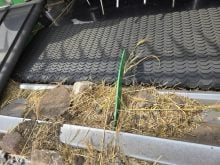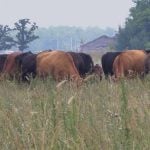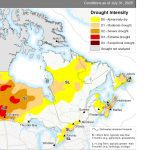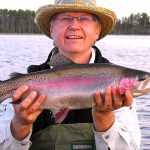Emerson, a red winter wheat variety with improved resistance to fusarium head blight, continues to command more western Canadian acres than any other winter wheat variety.
But newer varieties such as CDC Chase, AAC Elevate and AAC Wildfire are likely to gain acres over the next few years, especially in areas where fusarium pressure is lower.
Rob Graf, a winter wheat breeder with Agriculture Canada, said new winter wheat varieties will offer growers more options and higher yield potential.
But Emerson’s fusarium ratings will continue to attract growers in the eastern Prairies, he added.
Read Also

Dry bean seeded acreage in Manitoba hits 20-year high
Dry bean acreage across all types reached around 207,000 acres in 2025, representing a significant increase from last year’s 182,000 acres.
Emerson, developed by Agricultural Canada and distributed by Canterra, accounted for an estimated 36 percent of all winter wheat acres grown on the Prairies in 2017, followed by AAC Gateway (19 percent), Moats (12 percent), CDC Buteo (seven percent) and Radiant (seven percent).
“Emerson (is) the most popular across Western Canada, (especially) in Saskatchewan and Manitoba” said Graf, citing statistics from the Canadian Grain Commission’s Insured Acreage Report.
“Quite frankly, that was a little bit of a surprise to me…. It was thought initially that Emerson would be more of a niche variety… because it did carry with it somewhat of a yield penalty.”
“But the disease resistance on this variety — particularly the fusarium resistance — has really carried the day and, in fact, in Manitoba, it’s also among the top-yielding varieties so we’re not seeing that expected yield decrease there.”
In a recent presentation to winter wheat growers in Saskatoon, Graf highlighted promising winter wheat varieties that are likely to see good uptake by winter cereal growers.
Emerson has become a go-to variety across the West, thanks to its disease resistance package, good winter hardiness, short straw relative to Buteo, improved straw strength and slightly improved protein levels.
In the eastern Prairies, Emerson’s protein is typically half a percent higher than the winter wheat check variety, CDC Buteo.
But other varieties are generating interest as well.
AAC Gateway, for example, has gained acreage quickly since its commercial release in 2015, especially among growers in Manitoba and Alberta.
“Gateway has become quite popular in both Manitoba and Alberta, although not so much in Saskatchewan,” Graf said.
“In terms of yield, it’s very much like Buteo…. Winter hardiness is fair, much like CDC Falcon was.”
Gateway’s protein levels are typically half a percentage point higher than Buteo’s.
For specifics on yield, protein, winter survival and disease resistance, growers should check their provincial seed guides.
CDC Chase is another promising variety that shows significant potential.
Registered in 2013, seed supplies of Chase only became available to commercial growers last fall but in provincial trials, it showed a sizable yield bump over check varieties.
“I see this as a potential replacement for Moats,” Graf told growers.
“It has a nice yield bump over Buteo … and winter hardiness is fair.”
Over nine years of post-registration testing, Chase yielded nine percent higher than Buteo in the brown and light-brown soil zones of Saskatchewan and 10 percent higher in the black and grey soil zones.
Protein is slightly higher than check varieties and straw strength is rated as fair to good.
AAC Elevate is another newer variety that combines good yield potential with good winter survival and very good lodging tolerance, according to Saskatchewan trial data.
Yield results have been particularly impressive in southern growing areas where rainfall and soil moisture are typically limiting factors.
AAC Elevate became available to commercial growers in 2017. In post-registration trials, it out yielded Buteo by 10 percent in Saskatchewan’s brown and light-brown soil zones.
According to the Saskatchewan Seed Guide, it offers moderate resistance to bunt and stem rust, intermediate resistance to leaf rust and fusarium head blight, but is moderately susceptible to stripe rust.
“One thing I will say about Elevate is that… in southern Alberta… in extreme drought, this (variety) really shines,” said Graf.
“In fact, in 2017, at all of our southern Alberta locations, we had AAC Wildfire and Elevate in the same trials and you would swear looking at them that Wildfire would be the higher yielding variety but (it wasn’t). In those extreme drought conditions, it was Elevate.”
Despite playing second fiddle to Elevate in southern Alberta, AAC Wildfire is generating excitement for its high yield potential.
Although seed will not be available to commercial growers until the fall of 2018, trials in Saskatchewan over the past five years show Wildfire yields 16 to 17 percent higher than Buteo across all provincial soil zones.
Winter survival is rated as very good and lodging ratings are good.
Maturity relative to CDC Buteo is very late.
“There’s lots of excitement about this one,” Graf said.
AAC Goldrush also showed a significant yield advantage over Buteo in post-registration tests conducted in Saskatchewan.
Over four years of trials, Goldrush out yielded Buteo by 13 percent in brown and light-brown soil zones and by 20 percent at test sites in the grey and black soil zones.
Certified seed for AAC Goldrush may be available in the fall of 2018.
Overall, total winter wheat plantings in Western Canada declined for the sixth consecutive year last fall and are expected to hit their lowest levels since the late 1990s.
Seeded acreage across the Prairies was estimated at 335,000 acres last autumn, down from a high of more than 1.5 million acres 10 years earlier.
“The question is, is it a continuing trend or will we shoot back up to five or 600,000 acres next year and then be back to a normal level?
Your guess is as good as mine.”
About 90 percent of the winter wheat grown in Saskatchewan comprises Canada Western Red Winter varieties.


















